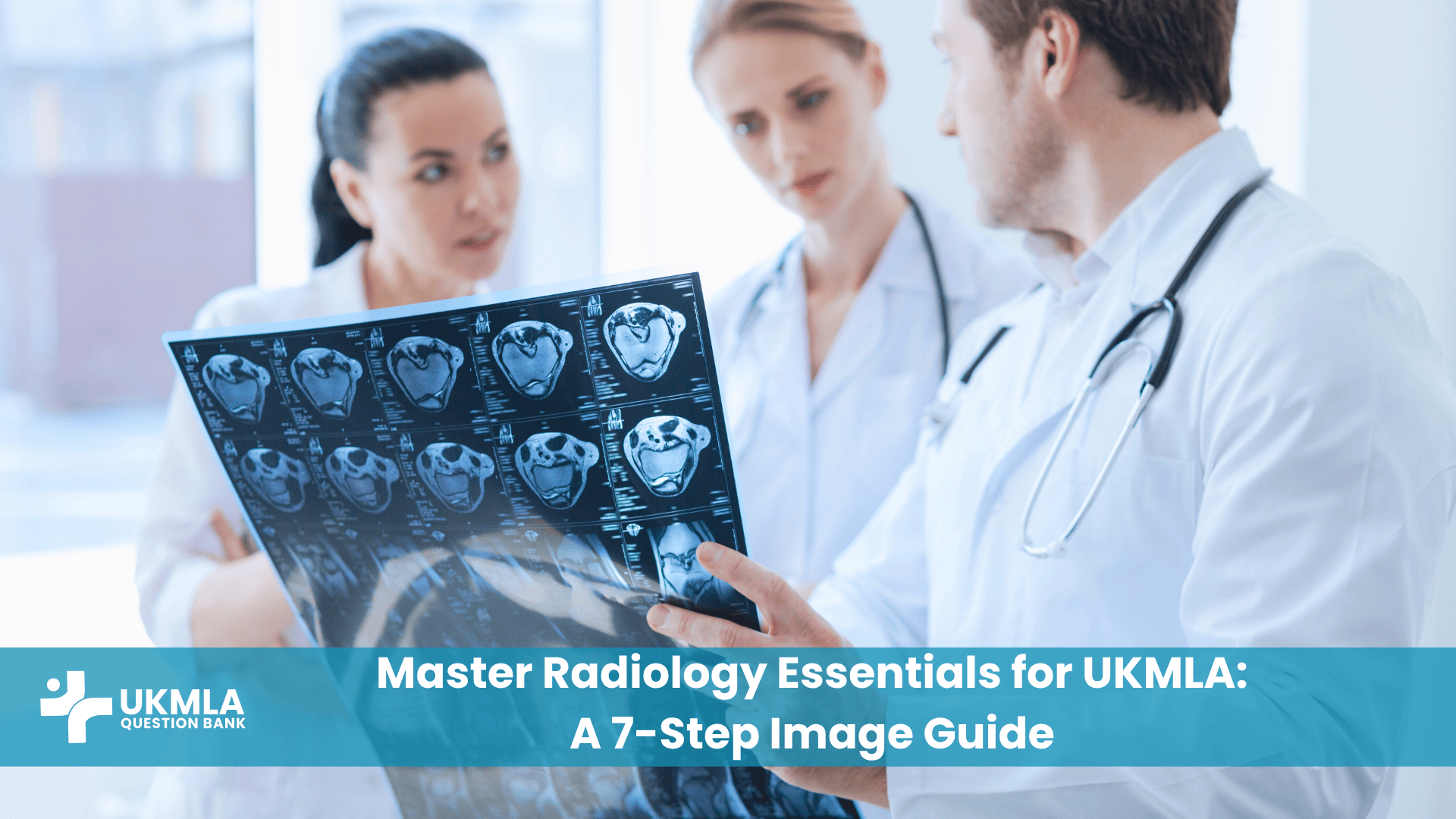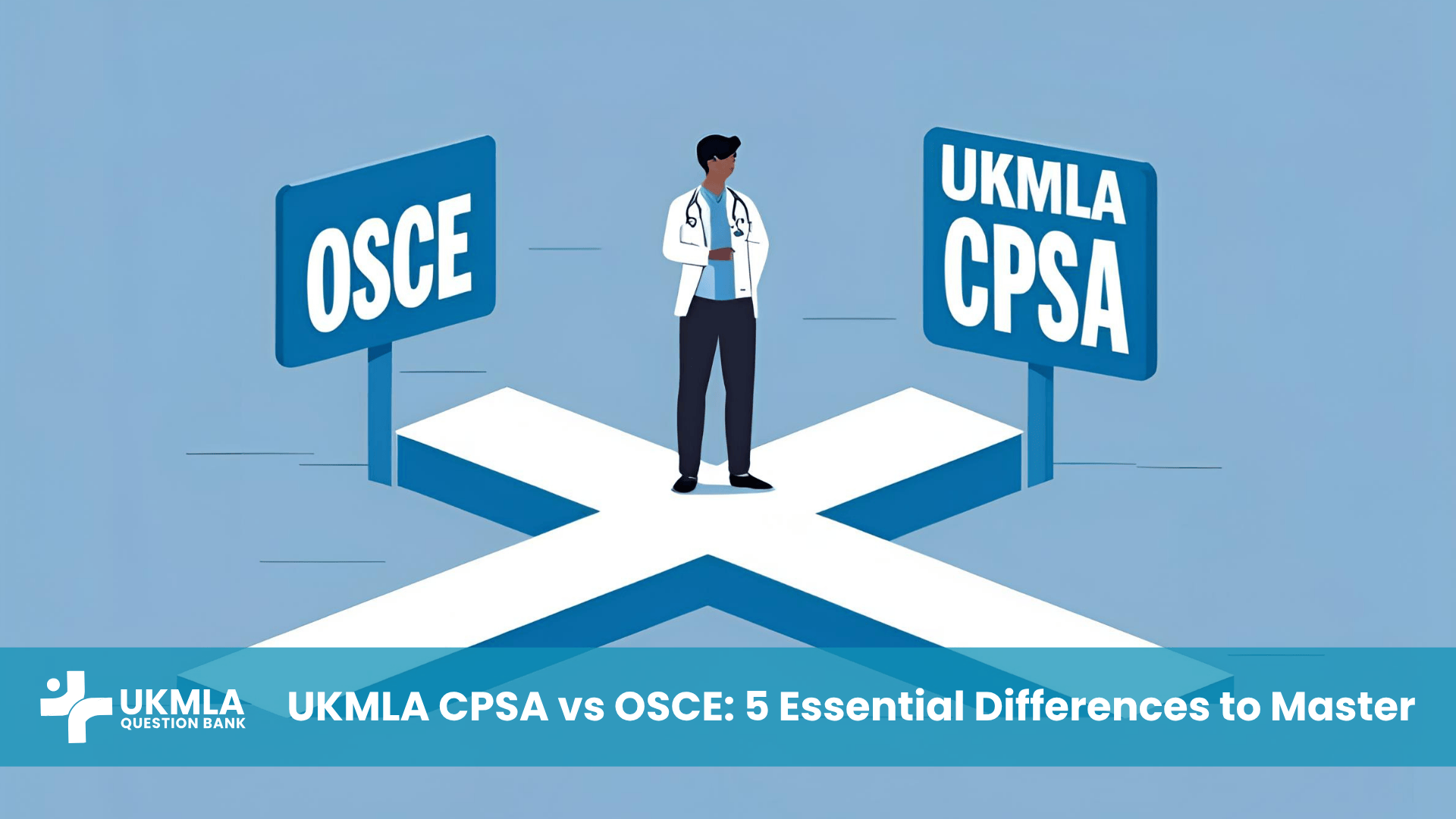Introduction
Mastering the radiology essentials for UKMLA is a core skill that separates a good medical student from a safe and competent junior doctor. While you are not expected to be a radiologist, the UK Medical Licensing Assessment (UKMLA) will rigorously test your ability to interpret common and critical findings on key imaging modalities. The Applied Knowledge Test (AKT) is less about spot-diagnosis and more about assessing your systematic approach to interpretation in a given clinical context.
This guide is designed to be your essential framework for success. We will provide a simple, repeatable 7-step process that you can apply to any imaging-based question. By learning to think systematically, you can deconstruct complex radiological scenarios, avoid common pitfalls, and confidently arrive at a safe and logical conclusion.
Table of Contents
ToggleA 7-Step Framework for Radiology Essentials for UKMLA
Success in radiology questions comes from having a robust and repeatable system. This 7-step framework will ensure you approach every question systematically, reducing errors and increasing your confidence.
Step 1: Check the Patient, Projection, and Date
This is the most critical safety step and must be your automatic first action. Before your eyes even glance at the image or report, you must confirm the fundamentals. Rushing past this step is a classic error.
Patient Details: Confirm you are looking at the correct patient’s imaging. In an exam, this means noting the name and date of birth provided. In real life, this prevents catastrophic errors.
Date and Time: Is this a recent image, or is it from a previous admission? Comparing a new chest X-ray to one from six months ago is a vital part of interpretation, allowing you to assess for change over time.
Projection: How was the image taken? A chest X-ray can be PA (posteroanterior) or AP (anteroposterior). An AP film, often taken on a portable machine for unwell patients, can magnify the heart and make the lungs look less clear, which is a crucial detail to note.
Step 2: Assess the Quality of the Image
A technically inadequate image can be misleading and lead to incorrect conclusions. A quick quality check is essential. For a chest X-ray, the mnemonic RIP is a high-yield tool.
Rotation: Is the patient straight? You can check this by seeing if the medial ends of the clavicles are equidistant from the spinous processes. Rotation can distort the appearance of the heart and mediastinum, potentially mimicking pathology.
Inspiration: Was it a good inspiratory effort? You should be able to count 5-6 anterior ribs or 9-10 posterior ribs above the diaphragm. A poor inspiratory film can crowd the lung markings at the bases and mimic consolidation or fluid.
Penetration: Is the exposure correct? On a well-penetrated film, you should just be able to see the thoracic vertebral bodies behind the heart. An under-penetrated (too white) film can hide pathology, while an over-penetrated (too black) film can make the lungs look falsely clear.
Step 3: Understand the Modality – What Are You Looking At?
You need a basic understanding of how different imaging modalities work to know what you’re seeing and what their strengths and weaknesses are.
Table 1: Comparison of Key Imaging Modalities
| Modality | Basic Principle | Best For | Key Limitation |
|---|---|---|---|
| X-ray | Uses ionising radiation to create a 2D image based on tissue density. | Bones (fractures), Chest (pneumonia, effusions), Abdomen (obstruction, perforation). | Poor soft tissue detail; uses radiation. |
| CT Scan | Uses X-rays to create detailed 3D cross-sectional “slices.” | Acute head bleeds, Chest (PE, cancer staging), Abdomen/Pelvis pathology, complex fractures. | High radiation dose; IV contrast carries risks. |
| MRI Scan | Uses powerful magnetic fields and radio waves; no radiation. | Excellent soft tissue detail (brain, spinal cord, muscles, ligaments). | Slow, expensive, noisy, contraindicated with certain metal implants. |
| Ultrasound | Uses high-frequency sound waves; no radiation. | Dynamic imaging, assessing fluid/cysts, Obstetrics & Gynaecology, Biliary system, vascular imaging. | Highly operator-dependent; poor penetration through bone or gas. |
For more detail on specific modalities, official patient information resources from bodies like the Royal College of Radiologists (RCR) are an authoritative source.
Step 4: Adopt a Systematic Review Pattern
This is the core of safe interpretation. Never “spot diagnose.” Always follow a structured pattern to ensure you don’t miss anything. For a chest X-ray, the ABCDE approach is a classic and effective system.
Airway: Is the trachea central? Is the carina visible?
Breathing (Lungs): Check both lung fields, comparing left to right. Look for symmetry, opacification, or abnormal lucencies. Trace the lung markings all the way to the edges.
Cardiac: Assess the cardiac silhouette (should be <50% of the thoracic diameter on a PA film) and the heart borders.
Diaphragm: Check the costophrenic angles (should be sharp) and look for free air under the diaphragm.
Everything else: Look at the bones (ribs, clavicles, vertebrae), the soft tissues, and any lines or tubes.
For more on applying this to specific conditions, our guide on high-yield respiratory management for UKMLA is a great resource.
Step 5: Identify and Describe the Main Abnormality
Once your systematic review is complete, you can focus on the abnormality. Use professional radiological language to describe what you see.
Instead of “a white bit,” use “opacification” or “consolidation.”
Instead of “a dark bit,” use “lucency.”
Describe the location (e.g., “right lower zone”), size, and characteristics (e.g., “a well-defined mass lesion,” “blunting of the left costophrenic angle,” “an air-fluid level”).
Crucially, also mention relevant negative findings. For example, “There is consolidation in the right lower lobe, with no associated pleural effusion or pneumothorax.”
6. Step 6: Formulate a Differential Diagnosis
Based on the radiological finding, create a list of potential causes. Your clinical knowledge is key here.
Example 1: If you see “blunting of the costophrenic angles bilaterally” and an enlarged heart, your top differentials would be causes of a transudative pleural effusion, like congestive heart failure.
Example 2: If you see “a well-defined, rounded opacity in the right upper zone,” your differentials would include lung cancer, a tuberculoma, or a benign lesion.
Clinical Pearl: “Radiology rarely gives a single, definitive answer. It provides patterns. Your job as a junior doctor is to take that pattern and create a clinically sensible list of differential diagnoses.”
Step 7: Correlate with the Clinical Vignette
This is the final and most important step, where you synthesize all the information. Take your differential diagnosis from Step 6 and see which one best fits the patient’s story from the vignette.
Example 1: If the patient with bilateral effusions also has a history of ischaemic heart disease and swollen ankles, congestive heart failure becomes the most likely diagnosis.
Example 2: If the patient with the lung lesion is a 70-year-old smoker with a history of haemoptysis and weight loss, lung cancer becomes the leading diagnosis.
This final correlation is the key to answering the SBA (Single Best Answer) correctly. For more on this synthesis, our guide on interpreting clinical data for the UKMLA AKT is essential reading.
Applying the 7-Step Framework to High-Yield Scenarios
Let’s briefly walk through how this applies to common exam scenarios.
The Systematic Chest X-ray (Pneumonia): You are given a vignette of a patient with a cough and fever. You apply the 7 steps: check the details, assess the quality (RIP), identify it as an X-ray, use your ABCDE approach, identify “opacification in the right lower zone,” form a differential (pneumonia, effusion), and then correlate with the fever and cough to make pneumonia the top diagnosis.
The Systematic Abdominal X-ray (Bowel Obstruction): The vignette describes a patient with vomiting and abdominal distension. You apply the 7 steps, identifying dilated loops of small bowel (>3cm) with visible valvulae conniventes, leading to a diagnosis of small bowel obstruction.
The Systematic CT Head (Extradural Haemorrhage): The vignette describes a young patient with a head injury who had a “lucid interval.” You apply the 7 steps to the CT report, which describes a “biconvex, lens-shaped hyperdensity,” allowing you to diagnose an extradural haematoma. For more on this, see our guide on Emergency Medicine Essentials.
A Note on Practice: “The only way to become proficient at radiology is through repetition. Every time you see an image on the wards or in a question bank, force yourself to go through a systematic review process. This builds the habits of a safe practitioner.”
Frequently Asked Questions (FAQ): Radiology Essentials
While possible, it is more common for the UKMLA AKT to provide a written radiology report that you must interpret. Your task is to understand the radiological terminology used in the report and integrate it with the clinical vignette.
CT uses X-rays, is very fast, and is excellent for imaging bone, acute bleeds, and the chest/abdomen. MRI uses magnetic fields, is much slower, and provides superior soft tissue detail, making it ideal for the brain, spinal cord, and joints.
Yes. You should understand the basic principle of ALARA (As Low As Reasonably Achievable). Know which modalities use ionising radiation (X-rays, CT scans) and which do not (MRI, Ultrasound). This is particularly important when considering imaging for pregnant patients or children.
IV contrast (usually iodine-based for CT) is used to highlight blood vessels and vascular organs. It is essential for diagnosing conditions like pulmonary embolism (on a CTPA) or for characterising tumours. It is contraindicated in patients with severe renal impairment or a known contrast allergy.
PA (posteroanterior) is the standard, high-quality view taken in the radiology department with the X-ray beam passing from back to front. AP (anteroposterior) is a portable view taken for unwell patients, with the beam passing from front to back. AP films magnify the heart and are generally less clear.
This is a common scenario. A scan performed for one reason might reveal an unexpected abnormality (an “incidentaloma”). The key is to assess the clinical significance. Is it something that requires urgent action, routine follow-up, or can it be safely ignored?
You should be able to recognise the signs of small bowel obstruction (dilated central loops >3cm, visible valvulae conniventes) and large bowel obstruction (dilated peripheral loops >6cm, visible haustra). You should also be able to identify free air under the diaphragm, which indicates a perforated viscus.
An ischaemic stroke may show no changes on an early CT head (its main role is to rule out a bleed). A haemorrhagic stroke will show as a bright white (hyperdense) area of blood within the brain parenchyma.
The vast amount of data from a CT scan is displayed by “windowing” it to look at specific tissue densities. For example, on bone windows, the bone is shown in high detail, but the brain tissue is indistinct. On brain windows, the brain tissue is clear, but the bone detail is lost.
The best way is to integrate your learning. When you study a condition like pneumonia, also look up its classic chest X-ray findings. Use a high-quality UKMLA question bank to practice applying the 7-step framework to realistic clinical vignettes with radiological reports.
Conclusion
Mastering the radiology essentials for UKMLA is about adopting a process, not just memorising pictures. By consistently applying the 7-step framework—from checking patient details to correlating with the clinical vignette—you can build a safe, reliable, and effective method for interpreting any imaging data presented in the AKT.
Remember that in the UKMLA, the clinical context is king. The radiological findings are a crucial piece of the puzzle, but they must always be synthesized with the patient’s story to arrive at the correct diagnosis and management plan. This systematic approach is the hallmark of a competent junior doctor and the key to your success in the exam.




